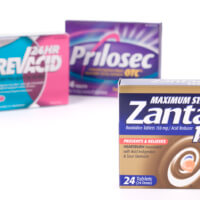http://chriskresser.com/

PPIs have become one of the most commonly prescribed classes of drugs in the industrialized world, despite increasingly frequent warnings by researchers about potential risks and complications.
A 2010 study found that of 946 patients receiving PPI therapy in a hospital setting, only 35 percent were prescribed PPIs for an appropriate upper GI diagnosis (1). In 2014, Americans filled more than 170 million prescriptions for acid blockers, falling only behind statins in total cost expenditure worldwide (2). PPIs are the most common of the acid blockers. They go by a variety of names but typically end in the suffix “-prazole” (omeprazole, pantoprazole, esomeprazole, etc.).
The purpose of this article is to provide an update to these earlier articles on heartburn and antacids, focusing on a number of scientific studies published in just the last few years. If you haven’t already, be sure to check out these previous blog posts.
The many roles of proton pumps in the body
Before we get into the potential harmful effects associated with PPIs, it’s important to understand what they do in the body. PPIs are inhibitors of proton pumps, specifically the proton/potassium pump of parietal cells in the stomach. The theory is that heartburn is caused by excess production of stomach acid by these cells, so inhibiting this proton pump will reduce the acidity of the stomach and prevent the burning sensation of acid reflux or the formation of peptic ulcers.
But proton pumps aren’t limited to the stomach; they are present in just about every cell in your body. All of your cells, with the exception of red blood cells, have mitochondria that allow your body to metabolize carbohydrates and fat to produce energy. They do this by pumping protons across the membrane to generate a source of electric potential that can be harnessed to form ATP, the body’s main storage form of energy. Without an efficient proton-pumping system, the body must rely on anaerobic systems for energy production, leading to rapid fatigue.
Proton pumps are also important in the transport of various substances in the body, as we will see in detail in later sections. And while proton pump inhibitors are designed to interact specifically with the hydrogen/potassium pump in parietal cells of the stomach, research suggests that they likely have nonspecific binding capabilities (3). In other words, their chemical structure enables them to bind to other proton pumps as well. Though PPIs don’t stay in the blood for very long, their binding to proton pumps is essentially irreversible—they will continue to inhibit the proton pump until the master antioxidant glutathione is able to facilitate dissociation (4).
PPIs can harm your heart, brain, kidneys, and gut. There are other alternatives.
PPIs alter the gut
The composition of microbes that inhabit your gut is incredibly sensitive to changes in the local environment. pH, a measure of the acidity of an environment, is an important facet of gut health and a particularly potent regulator of microbial communities (5). PPI use reduces the amount of acid produced in the stomach, and ultimately the amount of stomach acid that reaches the gut. This causes a significant shift in the pH of the intestines.
Indeed, several recent studies have shown that PPI alters the gut microbiota by reducing its overall diversity (6,7). Opportunistic pathogens, including Enterococcus, Streptococcus, Staphylococcus, and E. coli, tended to be more prevalent in the guts of PPI users.
As stomach pH becomes less acidic, many ingested microorganisms that would normally be destroyed are able to make their way into the gut (8). Imhann and colleagues found that oral bacteria, such as the genus Rothia, were over-represented in the gut microbiota of PPI users (7). Those who used acid blockers also had an increased chance of acquiring Clostridium difficile, Campylobacter, Salmonella, Shigella, Listeria, and community-acquired pneumonia than those using other medications (9,10).
A 2013 study also found a significantly increased percentage of individuals with small intestinal bacterial overgrowth (SIBO) among PPI users (11). Together, these studies point to the vital importance of sufficient stomach acid for protecting against bacterial influx into the GI tract and maintaining an intestinal pH that supports GI health.
PPIs impair nutrient absorption
Another consequence of long-term PPI use is impaired nutrient absorption, which I discussed extensively in a previous article. Stomach acid is essential for the absorption of many macro- and micronutrients. PPI users have been shown to have an increased risk of vitamin and mineral deficiencies, including vitamin B12, vitamin C, calcium, iron, and magnesium (12,13). Achlorhydria (a lack of stomach acid) and atrophic gastritis (stomach inflammation) allow for the overgrowth of bacteria, which compete with the host for consumption of micronutrients like vitamin B12 (14).
These micronutrients are particularly important for bone health. Studies have found an association between PPI use and total bone fractures in the elderly (15). While the association was modest, the findings were significant enough that the FDA felt it necessary to issue a news release in 2010 warning of the possible increased fracture risk (16). Since then, a more recent study has shown a similar association in young adult PPI users (17).
The effects of PPIs on bone health may be more nuanced than simply causing nutrient deficiency. Osteoclasts, the bone cells responsible for the resorption of calcium, also possess proton pumps, and their activity is thought to be directly affected by PPIs (18,19).
PPIs increase the risk of cardiovascular events
Several recent studies have also shed light on PPIs and the cardiovascular system. PPI users have been shown to have a significantly greater risk of heart attack than those on other antacid medication (20, 21). PPIs also reduce production of nitric oxide, a natural substance that promotes the dilation of blood vessels and improves blood flow (22).
PPIs may also damage blood vessel cells, as shown by a study published in May 2016. When researchers exposed cultured human blood vessel endothelial cells to esomeprazole, the cells seemed to age much more quickly, losing their ability to split into new cells. PPIs, which are designed to work especially well in acidic environments, seemed to inhibit an acidic compartment of the cell called the lysosome, which can be thought of as the cell’s “garbage disposal.” Without the ability to break down old proteins and other waste products of metabolism in lysosomes, “garbage” built up in the cells and inhibited their function (23).
PPIs harm the kidneys
The kidneys are also affected by PPIs. A study published in 2016 compared patients using PPIs to patients using H2 blockers, another common antacid drug. They showed that over the course of five years, those in the PPI group were 28 percent more likely to develop chronic kidney disease and 96 percent more likely to develop end-stage renal disease (24).
While the mechanism by which this occurs is unclear, we do know that proton pumps are present in the intercalated cells of the kidney. These proton pumps are responsible for moving protons into the urine, creating a gradient that allows for bicarbonate reabsorption into the blood (25). Bicarbonate is vitally important to maintaining proper blood pH.
PPIs negatively affect cognitive function
PPIs also impair cognitive function. A 2016 study found that regular PPI users had a 44 percent increased risk of dementia compared with those not using the drugs (26). A different study published in 2015 that assessed cognitive function in PPI users versus controls found statistically significant impairment in visual memory, attention, executive function, and working and planning function among PPI users (27).
Several commonly prescribed PPIs, such as lansoprazole and omeprazole, have been reported to cross the blood-brain barrier. In mice, PPIs were observed to affect β- and γ-secretase enzymes, resulting in increased levels of amyloid β, a protein fragment that forms the plaques characteristic of Alzheimer’s disease (28).
Furthermore, communication between brain cells requires the action of proton pumps. Simplistically, neuron cells contain small vesicles, or pockets, of neurotransmitters. When a neuron is stimulated, the vesicle releases these neurotransmitters into the synaptic space, where they can then interact with receptors on other nearby neurons, transmitting the signal down the line. The neurotransmitters must then be taken back up by the neuron so that they can be released again in response to the next stimulus. The energy required for this reuptake process is driven by proton pumps (29). If PPIs bind to these proton pumps, cognitive abilities would certainly be impaired.
PPI withdrawal can lead to rebound reflux
Your body is acutely sensitive changes in your physiology and is constantly trying to maintain a stable equilibrium, often termed homeostasis. In the case of PPIs, when it senses reduced stomach acid production, your body produces the hormone gastrin to try to compensate. Gastrin normally stimulates gastric (stomach) acid production.
Excess gastrin has in turn been shown to lead to an expansion of enterochromaffin-like cells (ECLs) (30). ECLs are found in the mucosa of the stomach in close proximity to parietal cells. A greater number of ECLs results in a greater amount of ECL hormones released that can interact with parietal cells. Parietal cells, as you may recall, are the cells responsible for stomach acid production via proton pumps. These parietal cells undergo hypertrophy, or an expansion in the size of each cell (31).
Larger parietal cells have more proton pumps and can produce larger amounts of stomach acid. This is termed “rebound hypersecretion,” or an overproduction of stomach acid after taking PPIs (32). This is why getting off PPI therapy is so difficult, because long-term use fundamentally changes the physiology of stomach cells. It also points to yet another instance where simply treating the symptoms of a condition fails to recognize and treat the underlying root cause.
Luckily, parietal cells are constantly undergoing renewal, with an average lifespan of only 54 days (33). So just because you took PPIs does not necessarily mean you are destined to rebound hypersecretion forever, as after a few months your stomach cells should have largely turned over. However, the repair mechanisms after PPI discontinuation have not been widely studied, and it is entirely possible that there are lasting effects.
Alternatives to PPIs
Collectively, these and many other studies suggest that PPIs are not as safe as they are made out to be. Frankly, it’s bordering on criminal that the FDA continues to allow these drugs to be prescribed as frequently as they are, and for durations of years or even decades in some cases, given the overwhelmingly large body of evidence documenting the potential harms associated with long-term PPI use.
If you’re convinced you should avoid PPIs, there are some alternatives (see my previous article for a more detailed discussion of these). Always consult with your medical practitioner before discontinuing the use of PPIs and be sure to reduce your dose gradually to avoid any withdrawal symptoms.
- Eat a low-carb Paleo diet
Malabsorption of carbohydrates can lead to bacterial overgrowth, resulting in the bloating and increased abdominal pressure that drives acid reflux. - Resolve low stomach acid and treat bacterial overgrowth
Contrary to conventional wisdom, acid reflux is often due to too little stomach acid, which results in bacterial overgrowth.
Now I’d like to hear from you. Have you taken PPIs? Did you know about the long-term dangers? Did you notice improvement in your acid reflux by switching to a Paleo diet or reducing your carbohydrate intake? Share your experience in the comments section!













 For now classes are 6pm and 640pm at 2840 Wildwood st in the Boise Cloggers studio.
Book your class NOW!
click this ==>
For now classes are 6pm and 640pm at 2840 Wildwood st in the Boise Cloggers studio.
Book your class NOW!
click this ==>








